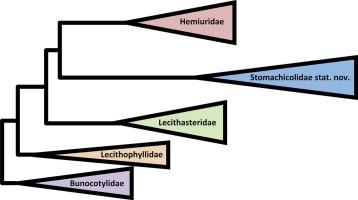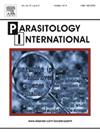A family concept for the genus Stomachicola Yamaguti, 1934 (Digenea: Hemiuroidea) and new hemiuroid species from marine fishes of Vietnam
IF 1.9
4区 医学
Q3 PARASITOLOGY
引用次数: 0
Abstract
New morphological and molecular data generated for hemiuroid trematodes from fishes of coastal waters of Cat Ba Island, Northern Vietnam. The trematode Stomachicola muraenesocis was detected in the intestines of eels Pisodonophis boro. Vietnamese specimens of S. muraenesocis were identical to trematodes from Iran by morphology and molecular data and have some differences with specimens from South Korea by 28S rRNA gene sequence data. Results of p-distance estimation and phylogenetic analysis of Hemiuroidea specimens of Stomachicola differ from other representatives of the superfamily at the level of different families. Based on these data, a new family for Stomachicola was created. A new species of the genus Lecithaster, L. pseudosayori n. sp., from belonid fish species was validated. These trematodes are close to L. sayori and L. confusus by morphological and molecular data, respectively. Two specimens of Lecithocladium sp. detected in belonid fishes were similar to L. excisum by both morphological and molecular data. Phylogenetic tree topologies show agreements about Lecithasteridae species differentiation and definitive host specificity.

越南海鱼半尿总科及半尿新种。
越南北部吉霸岛沿海水域鱼类类甲吸虫的形态和分子新资料。在鲫鱼肠道中检出村氏胃吸虫。越南产村氏绦虫标本形态和分子特征与伊朗产吸虫相同,28S rRNA基因序列与韩国产吸虫有一定差异。在不同科的水平上,胃科半总纲标本的p距离估计和系统发育分析结果与其他超科代表存在差异。基于这些数据,我们创建了一个新的口腔科。本文从贝类鱼类中发现了一新种:l.p pseudosayori n. sp.。这些吸虫在形态和分子上分别与sayori L.和confusus L.接近。在belonid鱼类中检测到的两个卵磷脂属(Lecithocladium sp.)标本在形态和分子上都与l.e exisum相似。系统发育树拓扑结构显示了卵磷脂科物种分化和最终宿主特异性的一致性。
本文章由计算机程序翻译,如有差异,请以英文原文为准。
求助全文
约1分钟内获得全文
求助全文
来源期刊

Parasitology International
医学-寄生虫学
CiteScore
4.00
自引率
10.50%
发文量
140
审稿时长
61 days
期刊介绍:
Parasitology International provides a medium for rapid, carefully reviewed publications in the field of human and animal parasitology. Original papers, rapid communications, and original case reports from all geographical areas and covering all parasitological disciplines, including structure, immunology, cell biology, biochemistry, molecular biology, and systematics, may be submitted. Reviews on recent developments are invited regularly, but suggestions in this respect are welcome. Letters to the Editor commenting on any aspect of the Journal are also welcome.
 求助内容:
求助内容: 应助结果提醒方式:
应助结果提醒方式:


